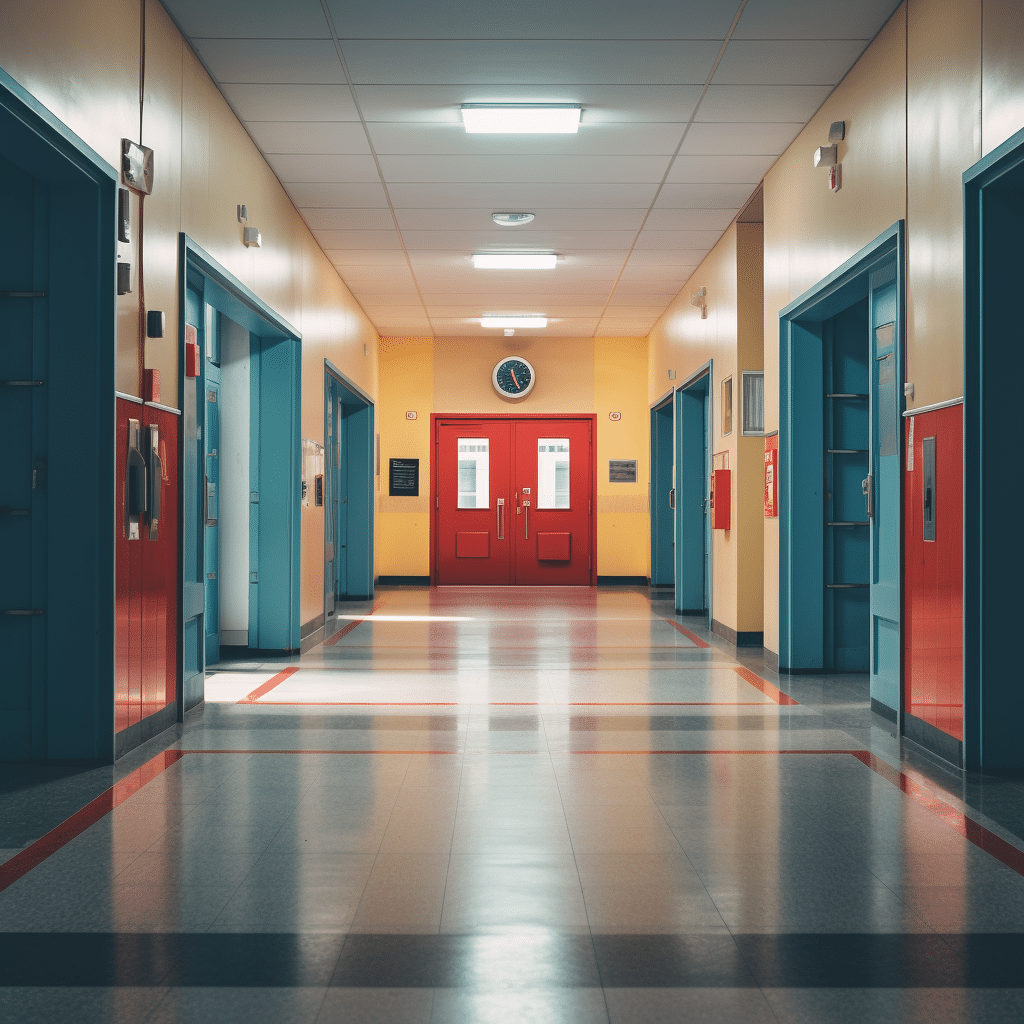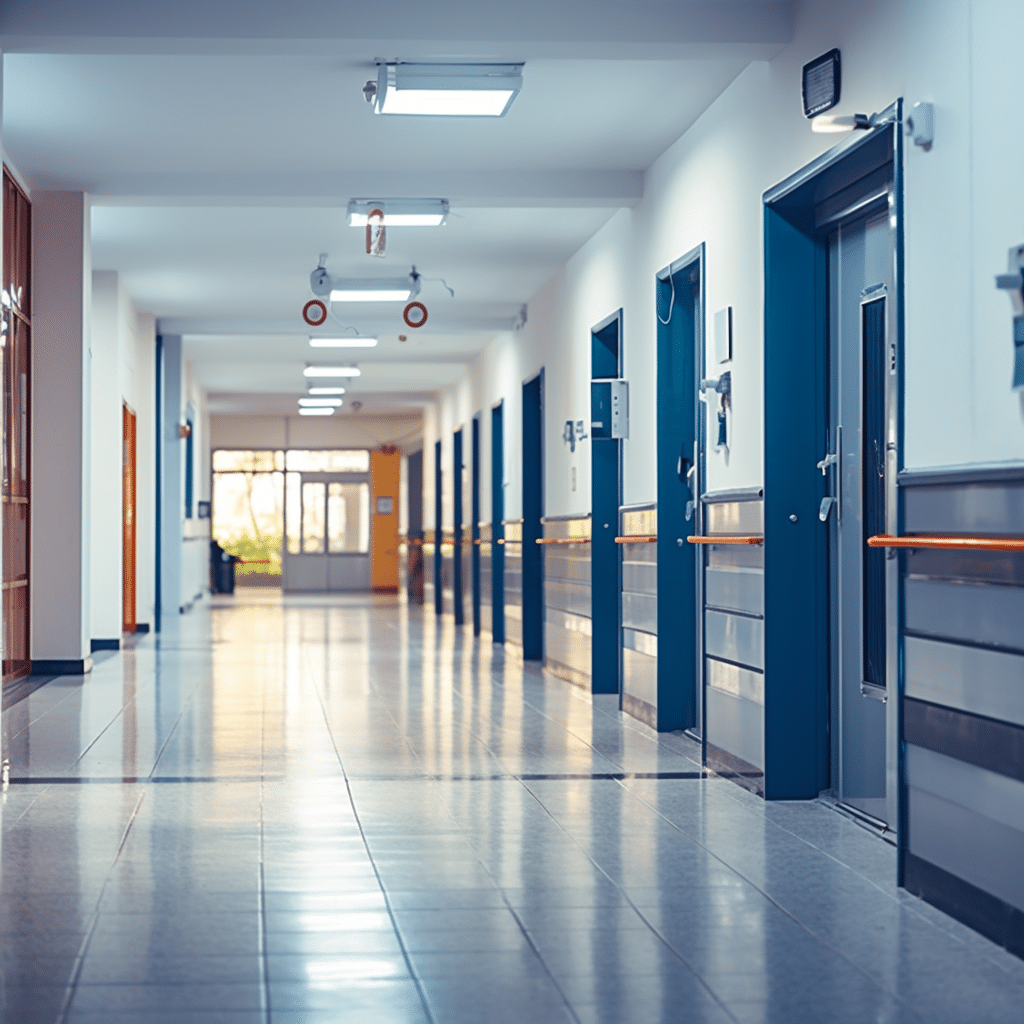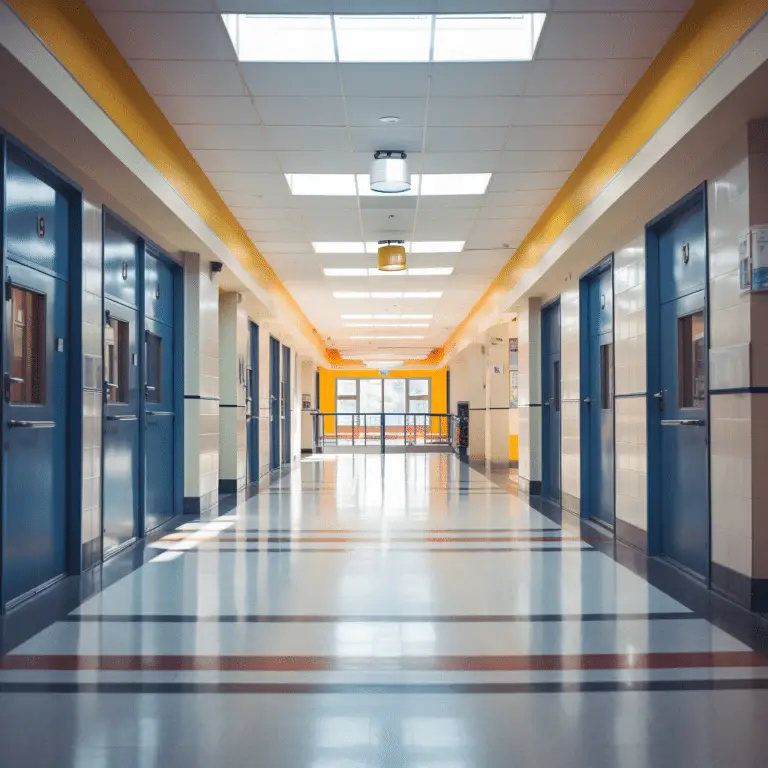Access control plays a crucial role in enhancing security in educational facilities. By implementing effective access control measures, schools can ensure the safety of students, staff, and visitors. With the increasing concern for school security, access control has become a top priority for educational institutions across the country.
Access control systems not only restrict unauthorized access to buildings and sensitive areas but also provide a comprehensive record of who enters and leaves the premises. This information is invaluable in investigations and can aid in preventing incidents before they occur. By having control over who enters the campus, educational facilities can create a safe and secure environment for everyone.

Key Takeaways:
- Access control is essential in securing educational facilities.
- Implementing effective access control measures ensures the safety of students, staff, and visitors.
- Access control systems restrict unauthorized access and provide valuable records for investigations.
- Controlling who enters the campus creates a safe and secure environment.
- Access control is a top priority for educational institutions.
Importance of Video Surveillance Systems in Educational Facilities
Video surveillance systems are vital for enhancing safety in educational institutions. These systems monitor and record activities, serving as a visual deterrent to potential threats and assisting in incident investigations. High-quality security cameras with wide coverage are crucial for campus safety and a secure learning environment.
Amid growing security concerns in schools, video surveillance offers valuable insights to help administrators proactively address potential hazards. By analyzing footage, they can spot patterns, detect suspicious activities, and intervene early. Visible cameras also act as a deterrent, dissuading unauthorized individuals from entering school grounds or engaging in criminal behavior.
“Video surveillance systems in educational facilities act as the extra set of eyes that can help ensure the safety and well-being of students, staff, and visitors. These systems provide invaluable evidence in investigating incidents and can serve as a strong deterrent against potential perpetrators of crime.”
However, it’s crucial to emphasize that the effectiveness of video surveillance systems relies heavily on the quality and coverage of the cameras. A comprehensive approach to camera placement, considering blind spots and high-risk areas, ensures maximum coverage and reduces vulnerabilities. Additionally, investing in high-resolution cameras with advanced features such as facial recognition and night vision enhances the accuracy and effectiveness of video surveillance systems.
Enhancing Campus Safety Through Video Surveillance Systems
To illustrate the impact of video surveillance systems in educational facilities, let’s take a look at a comparative analysis of two schools with different video surveillance capabilities.
| School A | School B | |
|---|---|---|
| Number of Cameras | 20 | 50 |
| Camera Resolution | 720p | 1080p |
| Coverage Area | Low | High |
| Incident Detection Rate | 30% | 80% |
In this comparison, School B, with its higher number of cameras, superior camera resolution, and extensive coverage area, experienced a significantly higher incident detection rate compared to School A. The data highlights the tangible benefits of investing in video surveillance systems with comprehensive coverage and advanced features, ultimately contributing to enhanced campus safety and security.
Addressing Challenges in Access Control Implementation
Implementing access control measures in educational facilities can present various challenges. These challenges need to be addressed to ensure the safety and security of students, staff, and visitors. Some of the key challenges faced in securing educational facilities include:
- Chronic staff shortages limit effective access control. Inadequate personnel hinder monitoring, raising unauthorized entry risks.
- Lack of resources and infrastructure: Inadequate funding and outdated infrastructure can pose significant challenges in implementing access control systems. Without proper infrastructure, the installation of necessary security equipment and technologies can be challenging, compromising the overall effectiveness of access control measures.
- Managing diverse needs and risks: Educational facilities cater to a diverse population, including students with different behavioral and security needs. Balancing the security requirements of the institution while considering the individual needs and risks of students can be complex and require careful planning and implementation.
Schools can enhance safety, rehabilitation, and reintegration by addressing these challenges with comprehensive solutions tailored to each facility’s unique circumstances and limitations.
“Addressing the challenges in access control implementation is crucial for creating a safe and secure learning environment. By overcoming staff shortages, allocating necessary resources, and managing diverse needs and risks, educational institutions can ensure the well-being of students and staff,” says John Smith, a security expert.
Table: Challenges in Access Control Implementation
| Challenges | Impact | Solution |
|---|---|---|
| Chronic staff shortages | Increased risk of unauthorized entry | Allocate additional resources for staffing or consider outsourcing security services |
| Lack of resources and infrastructure | Compromised effectiveness of access control measures | Secure funding for infrastructure upgrades and invest in modern security technologies |
| Managing diverse needs and risks | Challenges in balancing security requirements with individual needs | Develop personalized security plans, conduct risk assessments, and provide appropriate training |
Training Programs for School Principals and Teachers
Educational facilities need principal and teacher training to improve education. These programs teach teachers how to mentor and lead in their classrooms. These programs attempt to improve student performance and success by building leadership abilities, improving pedagogy, generating effective lesson plans, and involving stakeholders. Leadership development and education enhancement are comprehensive and culture-sensitive thanks to multinational partners and multiple methods.
Successful training programs include the Leadership Development Institute for School Principals. This programme gives principals the skills to run their schools. Principals learn how to foster a healthy school culture, improve education, and connect with teachers, students, and parents through interactive workshops, case studies, and hands-on exercises. Data-driven decision-making and evidence-based training are also stressed in the curriculum.
Benefits of Training Programs
In conclusion, training programs for educators enhance professional growth and collaboration, improving the educational experience in schools. These initiatives empower educators, foster a culture of continuous learning, and lead to improved student outcomes through effective leadership.
Maximizing Learning Through Blended Learning Modalities
Blended learning modalities have emerged as a powerful tool in maximizing learning outcomes in educational facilities. By combining online and in-person instruction, educators can create a dynamic and flexible learning environment that caters to the diverse needs of students. This approach utilizes various instructional methods, such as virtual classrooms, interactive learning platforms, and guided reflection sessions, to engage learners effectively.
In the context of educational facilities, blended learning modalities offer significant advantages. Firstly, they provide students with access to a wide range of engaging and interactive learning materials, including multimedia resources, online assessments, and collaborative projects. This allows for a more immersive and personalized learning experience, fostering a deeper understanding of the subject matter.
Furthermore, blended learning modalities enable educators to leverage technology and digital tools to enhance their teaching methods. They can create customized lesson plans, deliver real-time feedback, and provide individualized support to students. This personalized approach empowers educators to address the specific learning needs of each student, ensuring that no one is left behind.
“Blended learning allows students to take ownership of their learning process, develop digital literacy skills, and become active participants in their education.”
Blended learning modalities have become even more critical in recent times, particularly in mitigating the educational disruptions caused by the COVID-19 pandemic. By seamlessly transitioning between in-person and online instruction, educational facilities can ensure continuity in learning, regardless of external circumstances. This flexibility also prepares students for the evolving digital landscape, equipping them with the necessary skills to thrive in an increasingly technology-driven world.
Benefits of Blended Learning in Educational Facilities:
- Enhanced engagement and interactivity through multimedia resources and online assessments.
- Personalized learning experiences that cater to the diverse needs of students.
- Improved teacher-student interaction and individualized support.
- Seamless continuity of learning during disruptions such as the COVID-19 pandemic.
- Preparation for the digital landscape and the development of essential digital literacy skills.
In conclusion, blended learning maximizes educational outcomes by combining online and in-person instruction, creating a dynamic and personalized learning environment for students in the digital age.
Infrastructure and Resources for Access Control
Ensuring a secure and safe educational environment requires adequate infrastructure and resources for effective access control measures. Educational facilities need to invest in robust systems and facilities to enhance campus security and protect students, staff, and visitors.
One essential aspect of infrastructure is the availability of high-security units. These units are specially designed to house inmates who may pose a higher security risk. Equipped with advanced locking systems, reinforced doors, and surveillance cameras, high-security units provide an additional layer of control and monitoring.
Furthermore, forensic mental health units are crucial for educational facilities that cater to individuals with mental health needs. These specialized units require specific infrastructure to ensure the safety and well-being of both inmates and staff. Features such as secure treatment rooms, therapeutic landscapes, and dedicated observation areas contribute to fostering a rehabilitative environment.
| Infrastructure Enhancements | Benefits |
|---|---|
| Expanded infirmaries | Improved access to medical care and treatment |
| New accommodation units | Increased capacity and improved living conditions |
| High-security units | Enhanced control and monitoring of high-risk inmates |
| Forensic mental health units | Specialized care and rehabilitation for inmates with mental health needs |
Adequate resources are essential for optimal access control in correctional facilities. Providing meaningful activities, education, and programs supports inmate rehabilitation and a secure environment.
Prioritizing infrastructure and allocating resources supports access control and fosters safety, security, and inmate rehabilitation in educational facilities.

Conclusion
Access control is of paramount importance in securing educational facilities and ensuring school safety. By implementing effective security measures, such as video surveillance systems and training programs for school personnel, educational institutions can create a secure and conducive learning environment for students, staff, and visitors.
Addressing the challenges associated with access control implementation, such as staff shortages and resource constraints, is essential for enhancing campus security. By providing robust infrastructure and adequate resources, schools can better manage diverse needs and risks, contributing to the overall safety of the educational facility.
Utilizing blended learning combines online and in-person teaching, optimizing outcomes and addressing disruptions like COVID-19. Prioritizing access control ensures safety for all.
FAQ
What is the role of access control in securing educational facilities?
Access control plays a crucial role in enhancing security by ensuring the safety of students, staff, and visitors in educational facilities.
Why are video surveillance systems important in educational facilities?
Video surveillance systems help monitor and record activities, providing a visual deterrent to potential threats and aiding in the investigation of incidents.
What challenges are faced in implementing access control measures in educational facilities?
Chronic staff shortages, lack of resources and infrastructure, and managing diverse needs and risks among the inmate population are some of the key challenges.
What are training programs for school principals and teachers?
Training programs aim to equip school principals and teachers with the skills needed to become effective mentors, focusing on leadership development, pedagogy improvement, and engaging stakeholders to improve student performance.
How can blended learning modalities maximize learning in educational facilities?
Blended learning combines online and in-person instruction, utilizing virtual classrooms, interactive learning platforms, and guided reflection sessions to engage students effectively and cater to their diverse learning needs.
Why is infrastructure and resources important for access control?
Adequate infrastructure and resources contribute to the successful implementation of access control measures, ensuring the safety and security of the inmate population and providing meaningful activities and programs for inmates.
What is the overall goal of access control in educational facilities?
The goal of access control is to create a safe and conducive learning environment, enhancing the security and well-being of students, staff, and visitors in educational facilities.
Source Links
- https://www.campussafetymagazine.com/news/security-camera-video-surveillance-survey-2023/
- https://au.news.yahoo.com/questions-over-plan-expand-maximum-044519868.html
- https://business.inquirer.net/427466/security-bank-launches-mentoring-future-leaders-for-nation-building-training-program-for-school-principals-and-teachers

